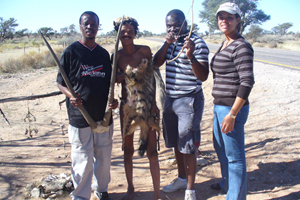San communities will care for returned land, says PhD graduate
17 February 2014
In the emotive and fractious battlefield that characterises land restitution in post-colonial and post-apartheid South Africa, the notion that restoring land to its historically rightful owners could damage the environment is often cited by those reluctant for the process to go forward.
Now, new research has shown that – at least in the case of the land claim by the Khomani San and Mier communities in the Kgalagadi Transfrontier Park – fears that these communities would be unable to maintain the health of the environment have proved baseless.
Johane Dikgang, who graduated with a PhD from UCT at the end of 2013, explored the delicate balancing act that characterises the Kgalagadi claim: "How to balance conservation and beneficiaries' rights to land and natural resources,†he said. As last year marked the centenary of the Natives' Land Act of 1913, which formalised the dispossession of black South Africans' land at the hands of colonial rulers, Dikgang's thesis is particularly relevant.
Dikgang says that the Kgalagadi land claim, unlike some others, was not characterised by a tussle over competing commercial interests. His research explored three core issues: first, whether land restitution helps reduce poverty; second, the value that the Khomani San assign to modern conservation under various land tenure arrangements; and finally, whether there was scope to generate additional revenue through conservation efforts, which could then be shared between the Khomani San and the national parks.
"We conducted face-to-face surveys in the Kgalagadi area, comparing 100 Khomani San households who used restituted land with another 100 households who did not. These 200 households were drawn from the 320 registered beneficiaries of the Khomani San land claim. Thus, the research restricted the sample to the Khomani San who could plausibly have taken up the offer to use the restituted land.â€
The data collected included detailed information on household income, consumption expenditure, access to nature, housing services, farming activities, and land use and migration patterns.
The results indicated that land restitution does not necessarily have any impact on poverty reduction. However, the Khomani San can be trusted to be good environmental stewards, and there is indeed scope to generate revenue for sharing between them and the national parks. Dikgang's thesis concluded that the Khomani San must be involved if conservation schemes in the Kgalagadi area are be successful.
"Given that the project involved a land claim inside a national park, we collaborated with South African National Parks,†says Dikgang. "The research project's findings are important because they may provide useful, policy-relevant information that will help well-informed decision-making with regard to sustainable resource use, equity, and poverty alleviation.â€
"The primary objective here was to investigate the value that the Khomani San assign to modern conservation under various land tenure arrangements, and to assess whether they may generally be expected to be good environmental stewards,†explained Dikgang. "To assess their attitudes towards biodiversity conservation, our study used the contingent valuation study of a plant conservation programme in the Kgalagadi to investigate the values assigned by the Khomani San and Mier communities to biodiversity conservation under three land tenure arrangements: communal land, municipal land, and parkland.
"Ninety-two percent of the Khomani San respondents supported implementation of the proposed biodiversity conservation programme on communal land, while 79% of these respondents supported implementation of the same programme on either municipal land or inside the park.â€
Given that more Khomani San respondents support than oppose the implementation of the proposed biodiversity conservation programme on any one of the land types, Dikgang concludes that the Khomani San people generally derive net positive benefits from the proposed biodiversity conservation programme, and that as a result, the majority of them would vote for its implementation.
"In contrast to the San, the Mier community were mainly interested in the economic benefits -- job creation and business venture opportunities -- that come about because of owning land.â€
Story by Yusuf Omar.
 This work is licensed under a Creative Commons Attribution-NoDerivatives 4.0 International License.
This work is licensed under a Creative Commons Attribution-NoDerivatives 4.0 International License.
Please view the republishing articles page for more information.










